Benefits of Juice Fasting Using Fresh Pressed Fruits and Vegetables
Juice fasting is a cleansing technique largely popularized in the mid
1930’s by Dr. Norman Walker, one of the first pioneers in the arena of
vegetable juicing, author of the book entitled “Fresh Vegetable and
Fruit Juices” and inventor of the Norwalk Juicer.
Presently becoming an accepted modern-day cleansing and detoxification technique, juice fasting basically involves the abstinence from eating solid foods for a number of days in a row, adhering to a diet of freshly pressed fruit and vegetable juice.
Many health experts agree that fasting on liquid juice is one of the most basic and effective dietary regime’s you can adhere to when feeling off-balance, sick, constipated, fatigued or stressed. It is often valued as one of the top ways to normalize digestive functions as well as renew and repair other bodily systems that are blocked up as a consequence.
Periodic fasting is one of the oldest methods for alleviating many
physical aches, pains and various health conditions. Benefits can be
achieved by drinking juices for breakfast or between meals throughout
the day, but deeper cleansing is known to occur when juices,
particularly those low in sugar and high in chlorophyll content, are
consumed exclusively for a period of time.
With extended juice
fasting, the liver, kidneys and colon are further able to process
toxins and undigested waste material that can overload normal biological
functions.
Because drinking fresh pressed juice still engages the digestive system, offering a supply of nutrients to the body, most people feel quite energized when consuming nothing but raw juice for many days in a row. Aside from arduous physical activity, the average person is usually able to perform normal everyday life activities, especially once potential detox reactions pass.
While intermittent juice fasting, anywhere from one day to several weeks, can be a beneficial way to rejuvenate the body and restore health, it is not recommended for growing children and pregnant or nursing mothers. We also highly advise consulting your healthcare provider before undertaking a fast if you are taking prescription drugs, are diabetic or have a serious health condition.
What is Detoxification?
As long as we are living with a functioning liver, colon and kidneys, the body is always in some state of detox, filtering out wastes and toxins. This is what these organs are designed to do. However, an accumulation of toxic substances can occur over time from unhealthy lifestyle habits, dietary excess and/or environmental pollutants we are all invariably exposed to on a daily basis.
This toxic waste build-up can impair health and create a chronic condition of low to high grade toxemia that can cause disease and a variety of health related issues.
Juice fasting helps to support the efficiency of these aforementioned cleansing organ systems.
Detoxification is a branch of alternative medicine that believes that when certain foods are eliminated from the diet, the body is more effectively able to pull out stored pollutants from the cells and tissues.
The
process of detoxification also involves a phenomenon known in physics as
“diffusion.” This process is accurately described in an article
published by the Tree of Life Rejuvenation Center, “If we lessen the
amount of toxins in the blood through dietary change, fasting, and other
processes, the law of diffusion tells us that the toxins concentrated
in the cells begin to flow back into the extra cellular fluid. Toxins
are diffused into the blood stream and then go to the liver, kidneys,
gastrointestinal tract, lymph, and skin systems – where they are
eliminated.”
Juice fasting is still regarded as a controversial subject not yet
entirely researched and supported by most of the mainstream medical
community, yet all one need do is attempt it for 1-3 days and the
process becomes quite clear and evident. Fasting works with the body’s
natural biological flow and helps to facilitate health and healing when
given the opportunity to do so.
In the words of health
educator Paul Bragg, “Our bodies have a natural self-cleansing for
maintaining a clean, healthy body and our “river of life” – our blood.
It’s essential we keep our entire bodily machinery from head to toes
healthy and in good working order so nothing breaks down! Fasting is the
best detoxifying method. It’s also the most effective and safest way to
increase elimination of waste buildups and enhance the body’s
miraculous self-healing and self-repairing process that keeps you
healthy and youthful.”
In a 2015 article entitled, “Fasting: Molecular Mechanisms and Clinical Applications”, evidence reveals that intermittent or periodic fasting in humans “helps reduce obesity, hypertension, asthma and rheumatoid arthritis.” In the review it also states that “fasting has the potential to delay aging and help prevent and treat diseases while minimizing the side effects caused by chronic dietary interventions.”
Although we believe that juice fasting is not necessarily going to heal and eliminate all health issues, it can be a good place to start by helping to improve digestive capacity as well as encourage a health promoting diet and lifestyle.
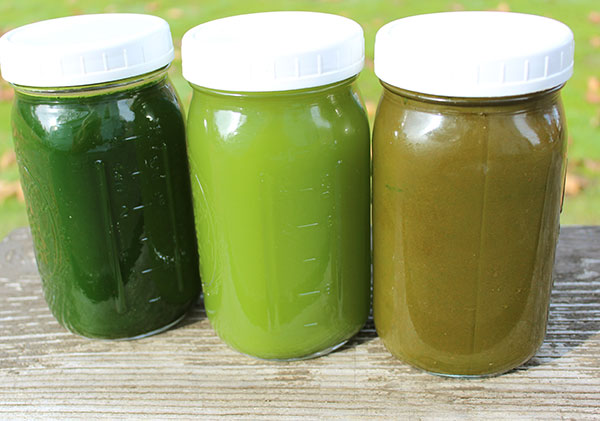
What are Detox Symptoms?
Many times when juice fasting people experience detox reactions like
headaches, nausea, irritability, lethargy, food cravings or skin
eruptions. These are usually all indications that the fast is indeed
working to get rid of toxic build up in the body. This is often referred
to as a “healing crisis.” It is important to understand that this is
commonly part of the detoxification process and that symptoms normally
pass quickly, frequently leaving you feeling way better than you did
before the detox episode.
The reason this is known to occur is
because the only way for poisons, heavy metals, plastic residues, waste
material, etc to leave the tissues is through the bloodstream and then
out of any one of the elimination channels. These contaminants are in
the blood temporarily before they exit the body, but while they are
moving through the bloodstream you might not feel so great or may
experience intense food cravings.
You will notice that, after
one to three days of a fast, it definitely becomes easier as potential
cravings dissipate, toxins are released from the blood and you feel
nutritionally satisfied and energetic. Many people, at this phase, have
no problem maintaining their routine life when drinking only juice
throughout the day. You will most likely experience very clear thinking
and become naturally inspired about your life.
Some doctors practicing “nutritional medicine”, describe the detox
phase as such “Fasting creates a condition of low concentration of toxic
wastes in the circulatory system. This is sensed by the plasma membrane
of each cell and each cell will then let go of its load of toxic
wastes. When this happens suddenly, as it does with fasting, the result
can be a sudden case of mild systemic toxemia as the system cleanses
itself. Those who fast must be prepared for a phase of headache,
irritability, insomnia and fatigue. This is a natural part of the
healing process and should be welcomed.” (Source)
Detox reactions can occur to a much larger degree when undertaking a water fast, which we highly recommend only under medical supervision. Juice fasting is a much gentler approach because the digestive process is still somewhat engaged as a concentrated influx of nutrients are constantly being provided.
Assisting the Detox Process
During the fasting process, as we discuss above, the body is cleaning itself on a cellular level, dissipating large pockets of clustered proteins and toxic debris into the bloodstream. It can therefore be considerably important at this time to help facilitate the evacuation of these waste products via the excretory organs, primarily the large intestine, the kidneys, the bladder, the lungs and the sweat glands.
This can be achieved by the use of enemas, colon hydrotherapy, drinking plenty of water and getting rest when you feel you need it. In addition, a daily practice of skin brushing, sauna sweating, abdominal massage and deep breathing exercises can be extremely beneficial during this time.
There
are also some supplements that can help to speed up detoxification,
especially after the re-feeding process. This may include zeolite, milk thistle, aloe vera gel, dandelion root tea, charcoal and chlorella. A product created by Healthforce Nutritionals called Intestinal Drawing Formula may also be of benefit.
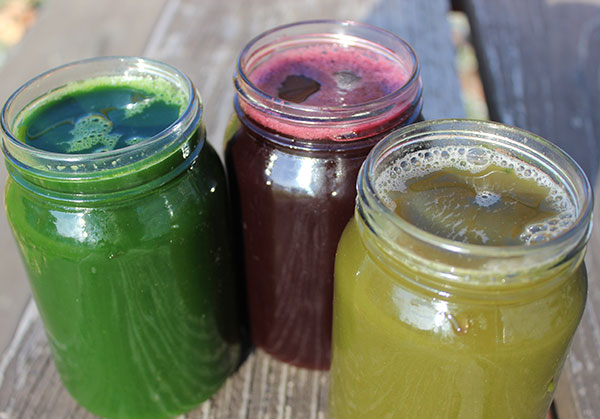
How to Juice Fast
Two of the most important factors to consider when juice fasting are “how to start” and “how to end” the fast. When both are done properly, you can severely reduce detox reactions as well as inspire healthy eating practices after the fasting period is complete.
1) How to Start a Fast
Depending on your level of health and current diet, it is generally
best to start a juice fast slowly rather than suddenly. We recommend
consuming at least one or two days of raw or blended fruits, sprouts and
vegetables, excluding all salt, oil, fat, sugar and any condiments from
the diet before you begin the fasting process. This will make the
transition easier when it comes time to drink nothing but juice for a
number of days in a row. This is also known to help lessen any detox
reactions that may occur.
Abruptly beginning juices right
after a day of junk food, probably the worst case scenario, will not be a
pleasant experience and will most likely inhibit you from wanting to
continue.
2) How to Break a Juice Fast
When it comes time to end a juice fast, it is very important that you do not overeat but consume small amounts of high quality fruits and vegetables over the course of a few days. As a guide, it is sometimes helpful to write down a menu plan for the next 3 days listing what you will eat (with exact amounts) and when you will eat it.
Immediately following a fast, the first taste of food initially makes
you want to eat more. Providing a meal schedule will assist you in
overcoming the urge to binge, which can have negative health
repercussions and counteract the positive outcomes attained.
Similar to when you started the fast, we also recommend slowly reintroducing new foods back into the diet, avoiding all fat, oil, salt and sugar. The first day it is often best to blend your foods as smoothies or raw soups. This provides pre-digested fiber that won’t overwhelm the digestive tract.
Next, begin introducing whole foods in the form of whole raw fruit and vegetables, by themselves or in salads. Over the course of 2-3 days, depending on the length of fasting period, you can gradually add small amounts of heavier fats, like avocados, back into the diet. It is best to continue eating mostly mono-meals at this point and eventually small portions of grains, beans, potatoes, refined oils, like coconut oil. If you are not vegetarian, meat and dairy should be the last food items introduced after a juice fast.
The “re-feeding
process” reinforces good dietary habits and typically requires a period
of no less than one-half the length of the fast.
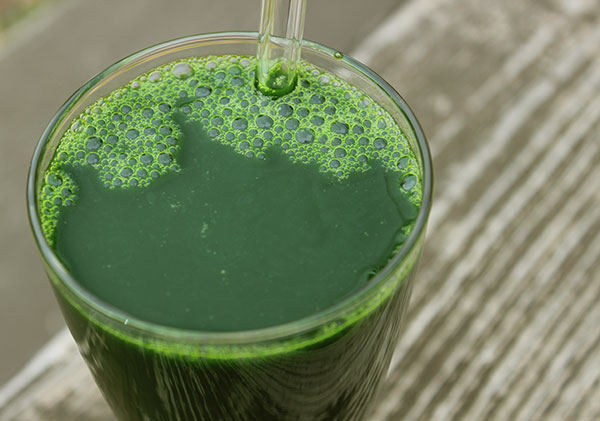
Juice Fasting Tips
1) Getting Ready for a Juice Fast
If you are making your own juices, it is nice to know where you can get a consistent supply of fresh produce in our local area. Aside from your own vegetable garden, sometimes farmers markets are ideal for providing some of the highest quality greens as well as rare and standard fruits and vegetables.
Before a juice fast is a great
time to clean out your refrigerator and make room on your counter-top
for your juicing needs. When you are fully stocked with enough for at
least 3 days of juicing, you will have plenty to remain disciplined and
provide for your juicing requirements.
2) What to Juice
For more about when to avoid cruciferous greens visit our page on non-cruciferous varieties.
The only juices we recommend consuming for juice fasting are green juices or those made with mostly low sugar fruits and chlorophyll-rich green leafy vegetables, with the occasional citrus juice or other sweet fruit added in but in diluted amounts. We discourage drinking concentrated fruit juices as they are way too high in sugar content.
For those looking to avoid excessive intake of cruciferous green
varieties, other options may include dandelion greens, chicory, gotu kola, escarole, moringa,
amaranth, radicchio, purslane, lovage, lambquarters and rosselle greens.
Generally, you will find the fruits and vegetables that appeal to you the most are usually the ones most appropriate to incorporate. The top list of juicing produce often includes: celery, cucumber, carrot, green and purple cabbages, green apple, beet, lemon, lime, and assorted greens like cilantro, kale, dandelion, bok choy, parsley and collards.
For flavor and additional health benefits you can also add in
small amounts of fresh green herbs and spices like fennel, mint, tulsi,
ginger, thyme, turmeric, fresh moringa and gotu kola
leaves as well as many wild green varieties. It is important to keep things varied and interesting to give
you something to look forward to drinking.
3) Drink Plenty of Water
Drinking pure water throughout the day between juicing is very
beneficial to help accelerate the detoxification process. Likewise,
adding a squeeze of lemon or lime is also a great cleansing tool and
will help you to feel full between glasses of juice.
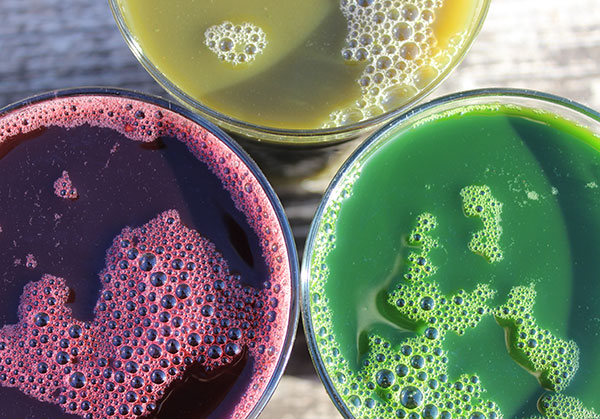
4) Preparing Juices
The only varieties of juice we advise drinking on a juice fast are freshly pressed raw, preferably organic, fruits and vegetables pressed through a juicer. Juices tend to lose their nutrient content and oxidize soon after the juicing process, especially if kept out at room temperature, so it is best to make them right before consumption. The second best option for those on a busy schedule is to keep them in a glass airtight container kept cold or frozen to preserve nutritional value.
We discourage the use of commercially made juices packaged
and processed to maintain a longer shelf-life. For those who find
preparing their own juices inconvenient, quality juice bars are also an
excellent alternative for meeting your needs and requirements.
5) How to Juice
Don’t have a juicer? Learn about how to juice with a blender!
The process of juicing does not necessarily require a juicing appliance, although they do come in handy. Juicers come in all shapes and sizes, but all essentially do one thing; they separate and extract the fruit or vegetable juicing liquid from the pulp fiber.
The best types of juicers for highest nutrient content don’t oxidize the juice and move at a very slow rotation speed. This includes brands like the Hurom, Omega and the Green Star juicer. Others, like the Breville, are available that will quickly juice in a matter of seconds, so it just depends on your priorities. Some are also easier to clean than others.
6) How Much to Drink
You may be surprised at how filling juices can be. Usually one half a quart to a one full size quart is an adequate amount to satisfy the appetite. By the time you notice you are hungry, its time for your next juicing meal.
Normally, it is advised to drink as much as you want whenever you want it so you don’t feel deprived. You will find that there is only so much liquid that you can actually comfortably drink without feeling nourished and full.
On average, 3 quarts a day
for the average sized adult is sufficient to provide what you need to
support energy levels and promote the healing process. It is, however,
always important to listen to your own body. You may want more or less
on any given day, or may wish to make small quantities of “snack juices”
between larger juicing meals if you desire.
7) Length of a Juice Fast
The length of the juice fasting period is unique to each individual and their response to the fast. It can be loosely predetermined, but overall duration should be followed according to the body’s reactions and benefits received. Some people with intentions to do a one day fast often find they wish to continue beyond the 24 hour period. Likewise, those who may aim for 2 weeks might find they need to stop after the first week.
The basic idea is to fast as quickly as possible, but
as long as necessary to achieve desired objectives. Again, it is
important to listen to what your own body needs at all times.
Recommended Juice Fasting Centers
1) Hippocrates Health Institute
The Hippocrates Health Institute has been the preeminent leader in
2) Tree of Life Rejuvenation Center
Tree
of Life offers a variety of different self-improvement retreats and
green juice fasting programs. Gabriel Cousins, founder of the center, is
author of the book “There Is A Cure For Diabetes”
and has done extensive research in this field, offering specific
programs for reversing diabetes naturally. (Watch this video on diabetes
here and learn about the other programs and retreats they offer.)
3) True North Health Center
The center provides medical supervised fasting for all conditions and states of health with a team of doctors who specialize in water-only fasting. They offer medical and chiropractic services, psychotherapy and counseling, massage and body work. They are very affordable and committed to making health available to all with great prices and rates.

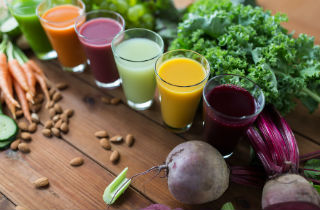 no
no no
no no
no